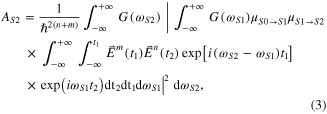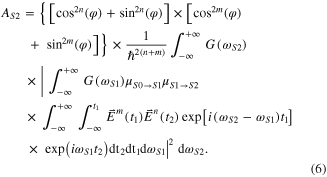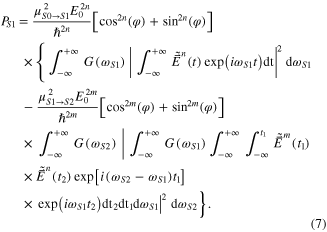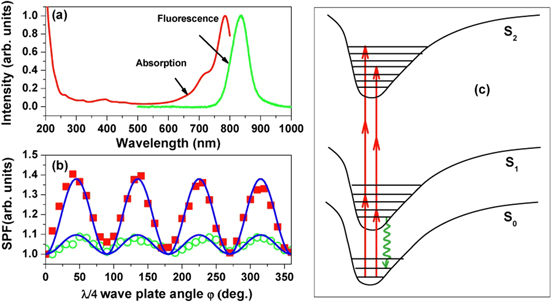Abstract
We theoretically and experimentally demonstrate the control of the intermediate state absorption in an (n + m) resonance-mediated multi-photon absorption process by the polarization-modulated femtosecond laser pulse. An analytical solution of the intermediate state absorption in a resonance-mediated multi-photon absorption process is obtained based on the time-dependent perturbation theory. Our theoretical results show that the control efficiency of the intermediate state absorption by the polarization modulation is independent of the laser intensity when the transition from the intermediate state to the final state is coupled by the single-photon absorption, but will be affected by the laser intensity when this transition is coupled by the non-resonant multi-photon absorption. These theoretical results are experimentally confirmed via a two-photon fluorescence control in (2 + 1) resonance-mediated three-photon absorption of Coumarin 480 dye and a single-photon fluorescence control in (1 + 2) resonance-mediated three-photon absorption of IR 125 dye.
Export citation and abstract BibTeX RIS
1. Introduction
Single- or multi-photon absorption or fluorescence in the molecular system has become a well-established tool that was widely applied on fluorescence correlation spectroscopy and fluorescence imaging spectroscopy and microscopy [1–4]. It is crucial to artificially enhance or suppress the molecular absorption or fluorescence to further extend its related applications. In recent years, a coherent control strategy by shaping the femtosecond laser pulse in the frequency domain, such as the laser phase, amplitude or polarization modulation, has opened a new opportunity to manipulate the molecular absorption or fluorescence, and several schemes have been proposed and experimentally realized [5–17]. For example, the single- or two-photon fluorescence can be enhanced or suppressed by the laser spectral phase and/or amplitude modulation based on either an open- or closed-loop scheme [5–16], and the two-photon fluorescence can be suppressed by the laser polarization modulation [17].
Recently, the intermediate state absorption control in the resonance-mediated multi-photon absorption process has attracted considerable attention because the target state absorption control was usually affected by its higher state absorption in an actual experiment [18–21]. For example, the single-photon fluorescence in IR 125 or IR 144 dye can be enhanced by the laser spectral phase modulation or polarization modulation, which is attributed to the higher excited state absorption [19–21]. However, these previous works just qualitatively explained the intermediate state absorption control and did not give the theoretical simulation. In order to better understand and control the intermediate state absorption in the resonance-mediated multi-photon absorption process, in this paper we theoretically and experimentally study the intermediate state absorption control in the resonance-mediated multi-photon absorption process by the polarization-modulated femtosecond laser pulse. Based on the time-dependent perturbation theory, we establish a theoretical model to describe the polarization-controlled intermediate state absorption in an (n + m) resonance-mediated multi-photon absorption process and obtain the corresponding analytical solution. We theoretically show that the laser intensity does not affect the control efficiency of the intermediate state absorption by the polarization modulation when the transition from the intermediate state to the final state is coupled by the single-photon absorption, but will affect this control efficiency when this transition is coupled by the non-resonant multi-photon absorption. Finally, we confirm these theoretical predictions by performing these experiments of two-photon fluorescence control in (2 + 1) resonance-mediated three-photon absorption of Coumarin 480 dye and single-photon fluorescence control in (1 + 2) resonance-mediated three-photon absorption of IR 125 dye.
2. Theoretical method
Figure 1 shows the schematic energy-level diagram of the (n + m) resonance-mediated multi-photon absorption process in the isotropic molecular system exited by the femtosecond laser pulse  where S0, S1 and S2 represent the ground state, the intermediate state and the final state, respectively. The transition from the S0 state to S1 state is coupled by n-photon absorption and the transition from the S1 state to S2 state is coupled by m-photon absorption. In our simulation, we consider the perturbative regime and that the interaction between the femtosecond laser field and the molecular system can be well described by time-dependent perturbation theory. In this case, the intermediate S1 state population PS1 in the (n + m) resonance-mediated multi-photon absorption process can be approximated as
where S0, S1 and S2 represent the ground state, the intermediate state and the final state, respectively. The transition from the S0 state to S1 state is coupled by n-photon absorption and the transition from the S1 state to S2 state is coupled by m-photon absorption. In our simulation, we consider the perturbative regime and that the interaction between the femtosecond laser field and the molecular system can be well described by time-dependent perturbation theory. In this case, the intermediate S1 state population PS1 in the (n + m) resonance-mediated multi-photon absorption process can be approximated as

where AS1 represents the n-photon absorption in the S1 state, which causes the population of the S1 state, and AS2 represents the (n + m) resonance-mediated multi-photon absorption in the S2 state, which causes the depopulation of the S1 state. In the molecular system with a broad absorption line, the multi-photon absorption can be considered as a sum of each individual transition. On the basis of the theoretical model of the atomic system with a narrow absorption line limit [22, 23], AS1 and AS2 can be written as

and

where  is the Planck constant,
is the Planck constant,  and
and  are the molecular absorption line-shape function in the S1 state and S2 state,
are the molecular absorption line-shape function in the S1 state and S2 state,  and
and  are the effective dipole coupling for the state transitions
are the effective dipole coupling for the state transitions  and
and  and
and  and
and  are the frequency for the state transitions
are the frequency for the state transitions  and
and  .
.
Figure 1. Schematic energy-level diagram of the (n + m) resonance-mediated multi-photon absorption process.
Download figure:
Standard image High-resolution imageWhen the femtosecond laser field with linear polarization, i.e.  is modulated by a quarter wave plate (
is modulated by a quarter wave plate ( wave plate), the output laser field can be written as
wave plate), the output laser field can be written as

where φ is the angle between the polarization direction of the input laser field and the optical axis of the  wave plate. One can see that the output laser is linearly polarized for φ = 0, π/2, π and 3π/2, circularly polarized for φ = π/4, 3π/4, 5π/4 and 7π/4, and elliptically polarized for the other rotation angle φ. In the (n + m) resonance-mediated multi-photon absorption process, all the n or m photons can only come from the same polarization direction, but between these n and m photons can be either the same polarization direction or different polarization directions. Thus, AS1 and AS2 in equations (2) and (3) can be further expressed as
wave plate. One can see that the output laser is linearly polarized for φ = 0, π/2, π and 3π/2, circularly polarized for φ = π/4, 3π/4, 5π/4 and 7π/4, and elliptically polarized for the other rotation angle φ. In the (n + m) resonance-mediated multi-photon absorption process, all the n or m photons can only come from the same polarization direction, but between these n and m photons can be either the same polarization direction or different polarization directions. Thus, AS1 and AS2 in equations (2) and (3) can be further expressed as

and

By normalizing equations (5) and (6) with  where E0 is the peak spectral amplitude, PS1 can be further simplified as
where E0 is the peak spectral amplitude, PS1 can be further simplified as

As can be seen from equations (5)–(7), both AS1 and AS2 depend on the laser polarization (i.e.  wave plate rotation angle φ). AS1 is proportional to
wave plate rotation angle φ). AS1 is proportional to ![$\left[ {{{\rm cos} }^{2n}}\left( \varphi \right)+{{{\rm sin} }^{2n}}\left( \varphi \right) \right]$](https://content.cld.iop.org/journals/0953-4075/48/13/135402/revision1/jpb514495ieqn18.gif) and AS2 is proportional to
and AS2 is proportional to ![$\left[ {{{\rm cos} }^{2n}}\left( \varphi \right)+{{{\rm sin} }^{2n}}\left( \varphi \right) \right]\times \left[ {{{\rm cos} }^{2m}}\left( \varphi \right)+{{{\rm sin} }^{2m}}\left( \varphi \right) \right],$](https://content.cld.iop.org/journals/0953-4075/48/13/135402/revision1/jpb514495ieqn19.gif) and therefore PS1 can be controlled by varying the laser polarization, but the control efficiency is correlated with the absorbed photon number n and m. Here, the control efficiency is defined by the function of η = (PS1_Max–PS1_Min)/PS1_Lin, where PS1_Max and PS1_Min are, respectively, the maximum and minimum values of PS1, and PS1_Lin is the value of PS1 by the linearly polarized laser excitation (i.e. φ = 0). In addition, AS1 is proportional to the nth power of the laser intensity (i.e.
and therefore PS1 can be controlled by varying the laser polarization, but the control efficiency is correlated with the absorbed photon number n and m. Here, the control efficiency is defined by the function of η = (PS1_Max–PS1_Min)/PS1_Lin, where PS1_Max and PS1_Min are, respectively, the maximum and minimum values of PS1, and PS1_Lin is the value of PS1 by the linearly polarized laser excitation (i.e. φ = 0). In addition, AS1 is proportional to the nth power of the laser intensity (i.e.  while AS2 is proportional to the (n + m)th power of the laser intensity (i.e.
while AS2 is proportional to the (n + m)th power of the laser intensity (i.e.  and thus the control efficiency of PS1, by varying the laser polarization, will be affected by the laser intensity that depends on the absorbed photon number m. When the transition from the intermediate S1 state to the final S2 state is coupled by the single-photon absorption (i.e. m = 1), the polarization modulation has the same effect on both AS1 and AS2 (i.e.
and thus the control efficiency of PS1, by varying the laser polarization, will be affected by the laser intensity that depends on the absorbed photon number m. When the transition from the intermediate S1 state to the final S2 state is coupled by the single-photon absorption (i.e. m = 1), the polarization modulation has the same effect on both AS1 and AS2 (i.e. ![$\left[ {{{\rm cos} }^{2n}}\left( \varphi \right)+{{{\rm sin} }^{2n}}\left( \varphi \right) \right]),$](https://content.cld.iop.org/journals/0953-4075/48/13/135402/revision1/jpb514495ieqn22.gif) and thus the control efficiency of PS1 by the polarization modulation is independent of the laser intensity. However, when the transition from the intermediate S1 state to the final S2 state is coupled by the non-resonant multi-photon absorption (i.e. m ≥ 2), the polarization modulation produces a different effect on AS1 and AS2, and therefore the control efficiency of PS1 will be affected by the laser intensity.
and thus the control efficiency of PS1 by the polarization modulation is independent of the laser intensity. However, when the transition from the intermediate S1 state to the final S2 state is coupled by the non-resonant multi-photon absorption (i.e. m ≥ 2), the polarization modulation produces a different effect on AS1 and AS2, and therefore the control efficiency of PS1 will be affected by the laser intensity.
3. Theoretical results
To demonstrate the above theoretical predictions, we theoretically simulate the control of PS1 by varying the laser polarization for the relatively high and low laser intensities, and the simulation results are presented in figures 2 and 3. Here, we consider two simple and representative cases of the intermediate state absorption control in (1 + 2) and (2 + 1) resonance-mediated three-photon absorption processes. In our simulation, the femtosecond laser pulse has the Gaussian shape with the central frequency of ω = 12 500 cm−1 and the pulse duration τ = 50 fs, and the molecular absorption in the S1 or S2 state (i.e. G(ωS1) or G(ωS2)) has also the Gaussian shape with the central frequency of ωS1 = nω or ωS2 = mω and the absorption bandwidth of ΔωS1 = ΔωS2 = 400 cm−1. Figure 2 shows the intermediate state population PS1 in a (2 + 1) resonance-mediated three-photon absorption process as a function of the λ/4 wave plate rotation angle φ with the laser intensities of (a) 3.6 × 1012 and (b) 4.3 × 1011 W cm−2 (blue squares, left coordinate), together with the two-photon absorption in the S1 state AS1 (red lines, right coordinate) and the resonance-mediated three-photon absorption in the S2 state AS2 (green lines, right coordinate). Here, these data of PS1 are normalized by the linearly polarized laser excitation, while these data of AS1 and AS2 are normalized by AS1 with the linearly polarized laser excitation, and hereafter the same method is utilized. One can see from figure 2 that both AS1 and AS2 decrease and have the same control efficiency when the laser polarization changes from linear to circular, and thus the laser polarization will induce the same control efficiency of PS1 for the high and low laser intensities (see equation (7)). So, one can conclude that the laser intensity will not affect the control efficiency of PS1 by the laser polarization modulation when the transition from the intermediate S1 state to the final S2 state is coupled by the single-photon absorption (i.e. m = 1).
Figure 2. The intermediate state population PS1 (blue squares, left coordinate) in the (2 + 1) resonance-mediated three-photon absorption process as a function of the λ/4 wave plate rotation angle φ with the laser intensities of (a) 3.6 × 1012 and (b) 4.3 × 1011 W cm−2, together with the two-photon absorption AS1 (red lines, right coordinate) and the resonance-mediated three-photon absorption AS2 (green lines, right coordinate). Inset in figure 2(b) shows the enlarged diagram of AS2.
Download figure:
Standard image High-resolution imageFigure 3. The intermediate state population PS1 (blue squares, left coordinate) in the (1 + 2) resonance-mediated three-photon absorption process as a function of the λ/4 wave plate rotation angle φ with the laser intensities of (a) 3.9 × 1012 and (b) 4.0 × 1010 W cm−2, and the single-photon absorption AS1 (red lines, right coordinate) and the resonance-mediated three-photon absorption AS2 (green lines, right coordinate) are also given together. Inset in figure 3(b) shows the enlarged diagram of AS2.
Download figure:
Standard image High-resolution imageFigure 3 shows the intermediate state population PS1 in the (1 + 2) resonance-mediated three-photon absorption process as a function of the λ/4 wave plate rotation angle φ with the laser intensities of (a) 3.9 × 1012 and (b) 4.0 × 1010 W cm−2 (blue squares, left coordinate), and the single-photon absorption in the S1 state AS1 (red lines, right coordinate) and the resonance-mediated three-photon absorption in the S2 state AS2 (green lines, right coordinate) are also presented. When the laser polarization changes from linear to circular, AS1 remains constant while AS2 decreases, and therefore PS1 increases. Since the laser polarization has a different effect on AS1 and AS2, the laser intensity will affect the control efficiency of PS1 by the laser polarization modulation, and the higher laser intensity yields the larger control efficiency. Consequently, it can be further deduced that the control efficiency of the intermediate state population will be affected by the laser intensity when the transition from the intermediate S1 state to the final S2 state is coupled by the multi-photon absorption (i.e. m ≥ 2).
4. Experimental confirmation
To confirm the above theoretical results of the intermediate state absorption control by varying the polarization modulation, we perform the experiment in Coumarin 480 dye and IR 125 dye with different laser intensities. In our experiment, we utilize a Ti-sapphire mode-locked regenerative amplifier (Spectra-Physics, Spitfire) as the excitation source with the pulse width (Full Width at Half Maximum) of about 50 fs, the central wavelength of 800 nm and the repetition rate of 1 kHz. An attenuator is used to vary the laser intensity, and a quarter wave plate ( wave plate) is employed to change the laser polarization from linear through elliptical to circular and vice versa. The polarization-shaped femtosecond laser pulse is focused into a quartz cuvette containing fluorescent dye with a lens of 200 mm focal length. The Coumarin 480 and IR 125 dyes are purchased from Exciton and used without further purification, which are dissolved in methanol solution with a concentration of 1.0 × 10−4 mol L−1. The fluorescence signal is perpendicularly collected and measured by a spectrometer with a charge-coupled device.
wave plate) is employed to change the laser polarization from linear through elliptical to circular and vice versa. The polarization-shaped femtosecond laser pulse is focused into a quartz cuvette containing fluorescent dye with a lens of 200 mm focal length. The Coumarin 480 and IR 125 dyes are purchased from Exciton and used without further purification, which are dissolved in methanol solution with a concentration of 1.0 × 10−4 mol L−1. The fluorescence signal is perpendicularly collected and measured by a spectrometer with a charge-coupled device.
Figure 4(a) shows the absorption (red line) and fluorescence (green line) spectra of Coumarin 480 dye. According to the position of the absorption and fluorescence peaks, it can be determined that the excitation process in Coumarin 480 dye is the (2 + 1) resonance-mediated three-photon absorption, as shown in figure 4(c). Figure 4(b) presents the normalized two-photon fluorescence intensity as a function of the λ/4 wave plate rotation angle φ with the laser intensities of 3.6 × 1012 (red squares) and 4.3 × 1011 W cm−2 (green circles), and the theoretical simulations are also given together (blue line). As expected, the laser intensity does not affect the control efficiency of the two-photon fluorescence intensity by varying the laser polarization. It can be found that this experimental result is consistent with the theoretical expectation. Similarly, on the basis of the absorption and fluorescence spectra of IR 125 dye in figure 5(a), the excitation process in IR 125 dye can be assigned as the (1 + 2) resonance-mediated three-photon absorption, as shown in figure 5(c). Figure 5(b) presents the normalized single-photon fluorescence intensity as a function of the λ/4 wave plate rotation angle φ with the laser intensities of 3.9 × 1012 (red squares) and 4.0 × 1010 W cm−2 (green circles), together with the corresponding theoretical simulations (blue lines). One can see that the control efficiency of the single-photon fluorescence intensity, by varying the laser polarization, decreases when the laser intensity decreases. Obviously, such an experimental result is also in good agreement with the theoretical predictions.
Figure 4. (a) The absorption (red line) and fluorescence (green line) spectra of Coumarin 480 dye. (b) The normalized two-photon fluorescence intensity as a function of the λ/4 wave plate rotation angle φ with the laser intensities of 3.6 × 1012 (red squares) and 4.3 × 1011 W cm−2 (green circles), together with the theoretical simulations (blue line). (c) The schematic energy-level diagram of (2 + 1) resonance-mediated three-photon absorption process in Coumarin 480 dye.
Download figure:
Standard image High-resolution imageFigure 5. (a) The absorption (red line) and fluorescence (green line) spectra of IR 125 dye. (b) The normalized single-photon fluorescence intensity as a function of the λ/4 wave plate rotation angle φ with the laser intensities of 3.9 × 1012 (red squares) and 4.0 × 1010 W cm−2 (green circles), together with the corresponding theoretical simulations (blue lines). (c) The schematic energy-level diagram of (1 + 2) resonance-mediated three-photon absorption process in IR 125 dye.
Download figure:
Standard image High-resolution image5. Conclusions
In conclusion, we have theoretically and experimentally shown that the intermediate state absorption in the (n + m) resonance-mediated multi-photon absorption process can be controlled by varying the laser polarization. A theoretical model was proposed to study the polarization-controlled intermediate state absorption based on the time-dependent perturbation theory, and an analytical solution was obtained. Our theoretical results showed that the laser intensity will not affect the control efficiency of the intermediate state absorption when the transition from the intermediate state to the final state is coupled by the single-photon absorption, which will affect it when this transition is coupled by the non-resonant multi-photon absorption. Furthermore, the two-photon fluorescence control in (2 + 1) resonance-mediated three-photon absorption of Coumarin 480 dye and single-photon fluorescence control in (1 + 2) resonance-mediated three-photon absorption of IR 125 dye were experimentally performed to validate these theoretical results. We believe these theoretical and experimental results are very helpful to further understand and control the intermediate state absorption in various resonance-mediated multi-photon absorption processes.
Acknowledgments
This work was partly supported by the National Natural Science Fund (Grant No. 51132004 and 11474096), and Shanghai Municipal Science and Technology Commission (Grant No. 14JC1401500).






